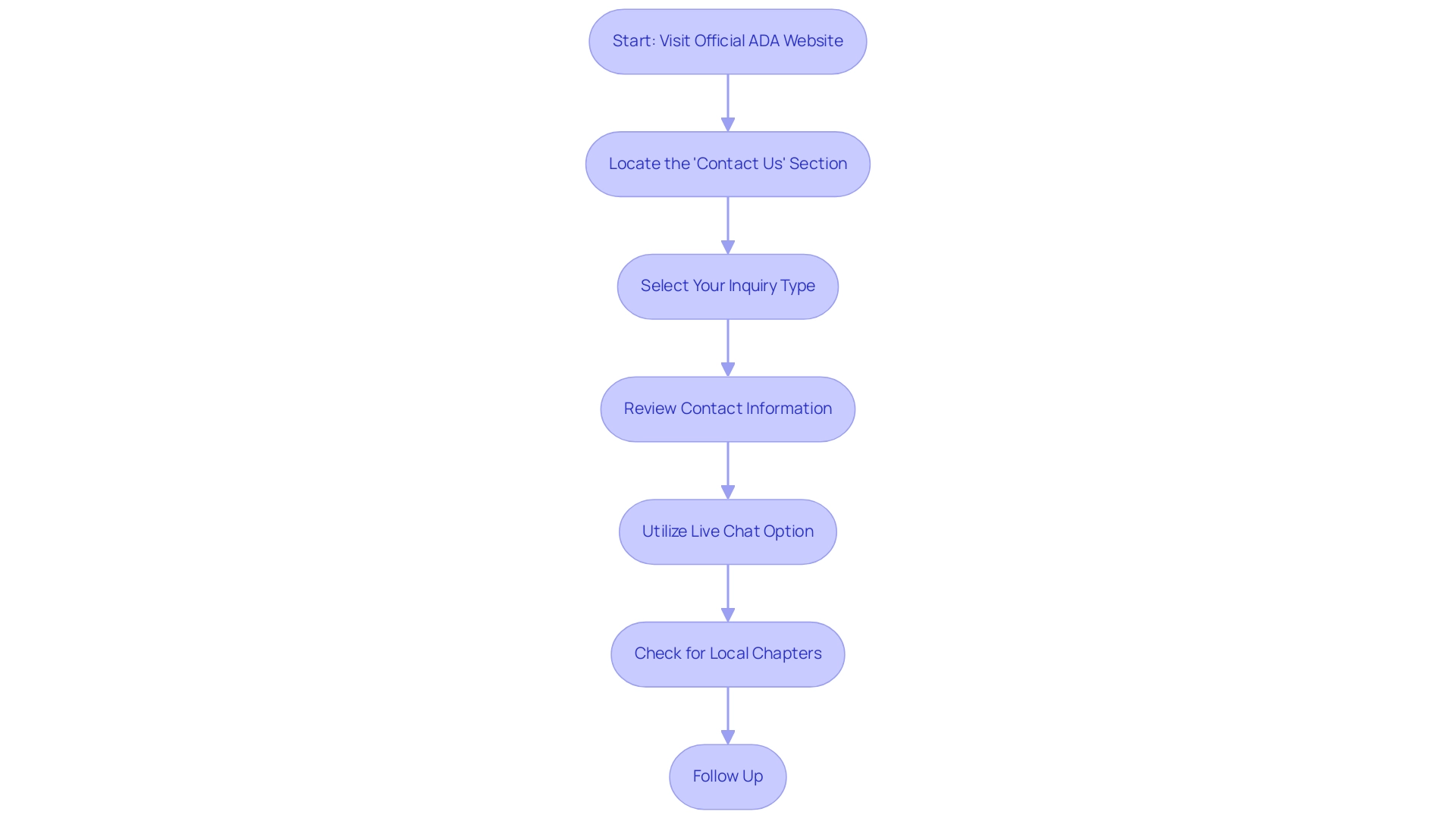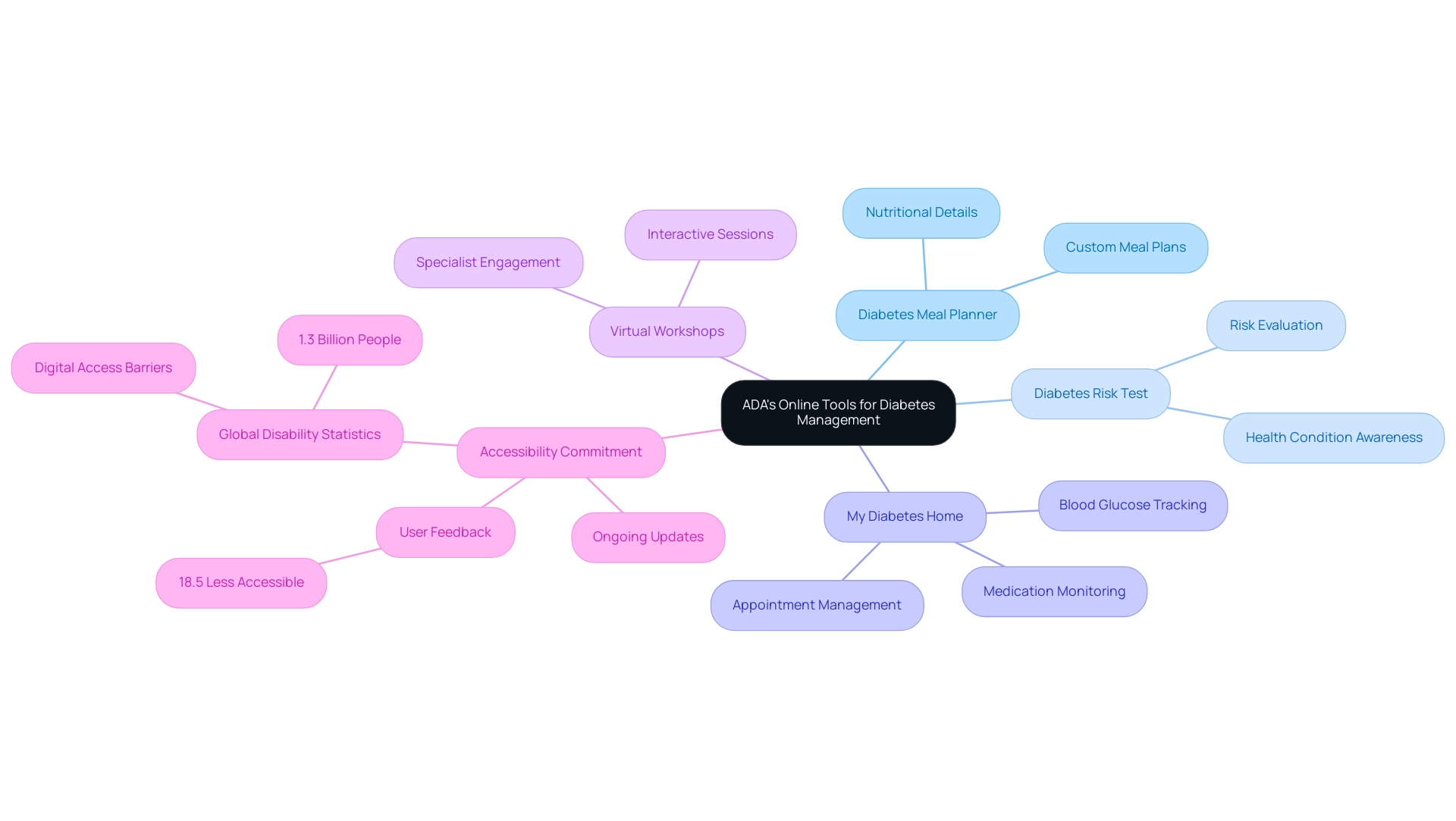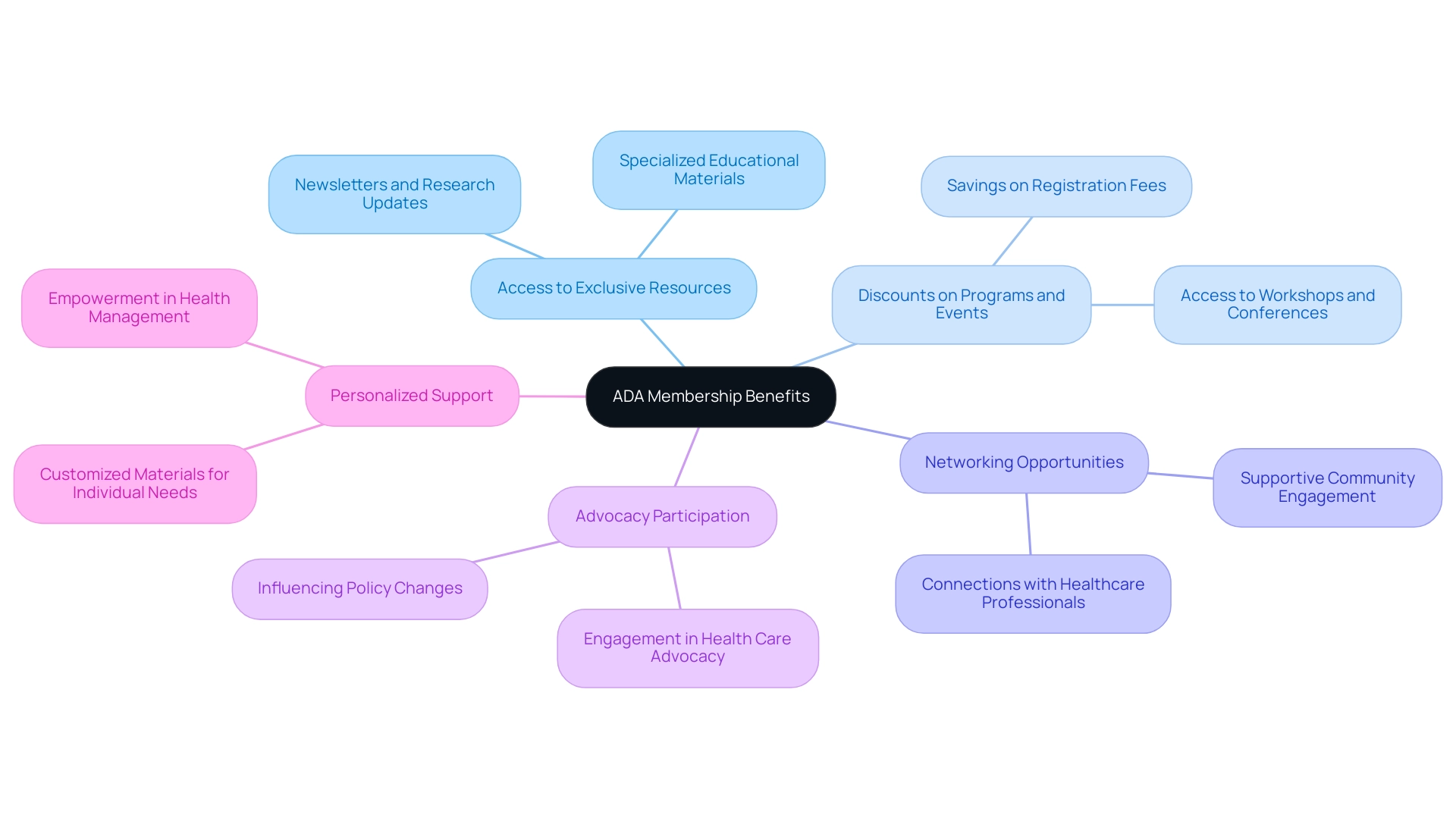Overview:
To access the American Diabetes Association (ADA) contact information, individuals should visit the official ADA website, navigate to the 'Contact Us' section, and select the relevant inquiry type to find specific contact details. The article outlines a structured approach for obtaining this information, emphasizing the importance of effective communication for diabetes management and providing additional resources like local chapters and support tools.
Introduction
Navigating the complexities of diabetes management can be overwhelming, especially for those newly diagnosed. The American Diabetes Association (ADA) serves as a pivotal resource, offering a wealth of information and support designed to empower individuals in their health journeys. This article outlines a step-by-step guide to accessing ADA contact information, explores the array of resources available, and highlights the importance of connecting with local chapters. Additionally, it delves into the benefits of ADA membership and the valuable tools provided by T2DSolutions, a new hub dedicated to Type 2 and Type 3 diabetes education. By understanding these resources and communication channels, individuals can take proactive steps toward effective diabetes management and community engagement.
Step-by-Step Guide to Finding ADA Contact Information
To efficiently obtain the American Diabetes Association contact information, adhere to the following structured steps:
-
Visit the Official ADA Website:
Start by going to the official site at www.diabetes.org, which acts as the main source for information pertaining to blood sugar management and assistance. Notably, the ADA plays a crucial role in addressing the condition, with a significant decrease in incidence observed after 2008, now at 8.4 per 1,000 adults. -
Locate the 'Contact Us' Section:
Scroll to the bottom of the homepage, where you will find a link labeled 'Contact Us.' Clicking this link will direct you to a dedicated page designed for inquiries. -
Select Your Inquiry Type:
On the 'Contact Us' page, various categories are presented, including General Inquiries, Donations, and Advocacy. Selecting the category that corresponds to your needs will ensure that you receive the most pertinent assistance. -
Review American Diabetes Association contact information:
Each category provides specific contact details, which may include phone numbers, email addresses, and sometimes a contact form related to the American Diabetes Association. Take note of the information relevant to your inquiry to facilitate communication. -
Utilize the Live Chat Option:
If available, consider engaging the live chat feature for immediate assistance. This option is typically located in the bottom right corner of the website and offers a convenient way to connect. -
Check for Local Chapters:
For those who prefer to contact a local chapter, the ADA website includes a section to locate local offices. Look for the 'Find Your Local Office' link to access specific contact details for your region. -
Follow Up:
After reaching out, if a response is not received within a reasonable timeframe, it is advisable to follow up using the same contact information to ensure your inquiry is addressed. This is especially significant as the case study 'ABCs of Diabetes Management' reveals that only 11.1% of adults met all criteria for A1C, blood pressure, cholesterol, and smoking, stressing the necessity for effective communication with health professionals.
Moreover, as T2DSolutions is launching as a new support hub for Type 2 and Type 3 education and community assistance, consider subscribing to T2D Solutions for updates and additional materials that can help in your management journey.

Exploring Resources and Communication Channels with the ADA
The American Diabetes Association (ADA) provides a comprehensive array of resources, including American Diabetes Association contact information, and communication channels designed to support people managing this condition effectively, while T2DSolutions serves as a vital hub for Type 2 and Type 3 education and community support.
-
Educational Materials: The ADA offers an extensive collection of brochures, online articles, and webinars focused on management, nutrition, and exercise. These educational materials are readily accessible in the 'Education' section of their website, ensuring individuals can easily find valuable information to aid in their self-management. A systematic review published in Diabetes Metab Syndr Clin Res Rev in 2020 demonstrated that self-management education for individuals with Type 2 Diabetes Mellitus (T2DM) can lower glycated hemoglobin (HbA1c) levels by an average of 0.5% to 1.0%. This highlights the critical role of such resources. As Yulian Wiji Utami observes, "Effective education regarding blood sugar management is essential for empowering patients to take control of their health."
-
Support Groups: Numerous local chapters of the ADA host support groups tailored for individuals with this condition and their families. These gatherings foster a supportive environment where participants can share personal experiences and practical advice, reinforcing the importance of community in managing health conditions. T2DSolutions also offers community support initiatives that complement these efforts. Research suggests that the prevalence of diagnosed health conditions related to blood sugar is significantly influenced by education levels and socioeconomic status, with 13.1% of adults with less than a high school education diagnosed compared to 6.9% of those with more than a high school education. Support groups play an essential role in tackling these disparities by offering assistance and a sense of belonging.
-
Advocacy: The ADA engages actively in advocacy efforts aimed at influencing policies that impact medical care. Comprehensive information, including the American Diabetes Association contact information, regarding these initiatives can be located in the 'Advocacy' section on the ADA website, enabling people to engage in efforts to enhance care at the legislative level. T2DSolutions motivates its community to engage in advocacy as well, offering support and guidance.
-
Social Media: For ongoing updates, tips, and community stories, individuals can follow the ADA on popular social media platforms such as Facebook, Twitter, and Instagram. This digital engagement is an effective way to stay informed about upcoming events and initiatives related to blood sugar control. T2DSolutions will also share valuable insights and updates through its social media channels.
-
Email Newsletters: Subscribing to ADA newsletters is an excellent way to receive the latest news and educational materials directly in one’s inbox. This service is easily accessible through the subscription options on the website, ensuring people remain connected to current developments in diabetes education. Additionally, T2DSolutions will provide subscription options for updates on new resources and content, keeping the community informed.
-
Phone Support: The ADA provides dedicated phone support for a wide range of inquiries, including health-related questions and resource assistance. It is advisable to consult the specific phone numbers listed under the relevant categories on their contact page, particularly the American Diabetes Association contact information, ensuring that people can access the help they need promptly. T2DSolutions will also provide support channels to help people in managing their health journey.

Utilizing the ADA's Online Tools and Resources
The American Diabetes Association (ADA) offers a variety of online tools and materials, including american diabetes association contact information, to assist individuals managing blood sugar levels. These tools are designed to enhance accessibility and usability, ensuring that users can effectively navigate their health journey, especially in light of the fact that 48% of the most popular federal websites in the US don’t meet basic standards for accessibility. Among these materials are:
-
Diabetes Meal Planner: This innovative tool assists users in crafting personalized meal plans that cater to their specific dietary needs and preferences. The planner not only streamlines the process of monitoring carbohydrate consumption but also offers comprehensive nutritional details, making it an essential tool for effective management of blood sugar levels.
-
Diabetes Risk Test: This quick online assessment allows users to evaluate their risk of developing type 2 diabetes. By finishing this assessment, individuals acquire understanding of their personal health condition, which is a vital initial action in proactive health management.
-
My Diabetes Home: This extensive online platform acts as a central hub for tailored management materials. It includes tracking tools for monitoring blood glucose levels, medications, and upcoming appointments, empowering users to take control of their care for this condition.
-
Virtual Workshops: The ADA regularly hosts virtual workshops and webinars covering a variety of topics related to managing this health issue. These sessions not only spread valuable information but also enable direct interaction with specialists in blood sugar management, fostering a supportive community.
These online materials exemplify the commitment of the American Diabetes Association, including their contact information, to providing accessible and effective tools for managing blood sugar levels. Ongoing updates and improvements guarantee that these tools stay pertinent and easy to use, catering to the changing requirements of those managing blood sugar conditions. However, it is important to note that 18.5% of users believe that accessibility has become less effective, highlighting ongoing challenges.
Moreover, an estimated 1.3 billion people worldwide live with some form of disability, and many face significant digital access barriers. This highlights the significance of the ADA's mission to improve accessibility in its materials, guaranteeing that all persons, including those with disabilities, can effectively control their condition.

Connecting with ADA Local Chapters
Connecting with local chapters of the American Diabetes Association (ADA) is a crucial step for newly diagnosed individuals seeking American Diabetes Association contact information and support. T2DSolutions is here to serve as your thorough aid for Type 2 and Type 3 blood sugar management, empowering you with essential tools and community support. Here are the steps to effectively engage with your local ADA chapter:
- Visit the Local Chapters Page: Begin by navigating to the ADA website and locating the 'Find Your Local Office' section. This tool will assist you in identifying the chapters available in your area, ensuring you have access to nearby support.
- Select Your State: Choose your state from the dropdown list provided on the website. This action will direct you to specific local offices, along with the American Diabetes Association contact information, allowing for streamlined communication.
- Explore Local Programs: Each local chapter provides a range of educational initiatives, support groups, and community activities designed to address the varied needs of individuals with blood sugar issues. Take the time to review these offerings, as they can significantly enhance your understanding and management of diabetes.
- Reach Out: Do not hesitate to contact your local office directly for American Diabetes Association contact information. Use the phone number or email address provided to inquire about available assistance, ask questions, or express any concerns you may have regarding health management.
- Attend Local Events: Participating in local events, such as health fairs, workshops, and community gatherings, can offer extra support and valuable networking opportunities. Taking part in these events not only assists in your education but also cultivates relationships with others who are dealing with blood sugar issues, strengthening the community support network.
Alongside these measures, it is crucial to acknowledge that local ADA chapters have a vital role in empowering people with blood sugar challenges through continuous support and resources. As Ann Reesman, General Counsel of the Equal Employment Advisory Council, stated,
The ADA has promoted some great strides... empowering people who didn't otherwise feel that they could come forward and compete for a job.
This empowerment extends to health management, highlighting the importance of local chapters in enhancing the lives of those affected by diabetes.
It's important to understand that compliance with ADA regulations is vital, as violations can result in civil penalties of up to $50,000 for first offenses and $100,000 for subsequent violations. This highlights the significance of local chapters in supporting people with disabilities, including those with diabetes-related conditions. Furthermore, new facilities constructed for designated public transportation services must be accessible, reflecting the ADA's commitment to inclusivity.
Moreover, while local chapters provide essential support, organizations must also navigate the costs of compliance with the ADA. Despite critiques that reasonable accommodations create financial challenges, numerous employers have effectively set up roles and committees to support these adjustments, ultimately benefiting those with diabetes.
T2DSolutions is prepared to help you in exploring these tools and engaging with your community.
Upcoming Events: T2DSolutions will soon be organizing a series of workshops and community gatherings focused on offering education and assistance for those managing their condition. Stay tuned for details on dates and locations, and consider subscribing to our newsletter for updates on these opportunities.
What’s Next for T2DSolutions: As we continue to develop our offerings, T2DSolutions aims to create a vibrant community hub for people affected by health issues. We are dedicated to offering extensive materials and assistance, ensuring that you possess the tools essential for effective management of blood sugar.

Understanding ADA Membership Benefits
Joining the American Diabetes Association (ADA) provides numerous advantages aimed at assisting individuals managing their condition, and enhances the tools accessible through T2DSolutions, a newly established center for Type 2 and Type 3 education and community support, which includes American Diabetes Association contact information in its early stages. Key advantages of ADA membership include:
- Access to Exclusive Resources: Members gain entry to specialized educational materials, newsletters, and updates on the latest research and advancements in managing blood sugar. These resources are crucial for staying informed and empowered in one’s health journey.
- Discounts on Programs and Events: Membership provides significant savings on registration fees for conferences, workshops, and various educational events organized by the ADA. This access not only enhances learning but also fosters engagement with the community related to the condition.
- Networking Opportunities: Joining the ADA facilitates connections with healthcare professionals and peers living with the illness. This networking fosters a supportive community that can share experiences, tips, and encouragement, which is invaluable for newly diagnosed individuals.
- Advocacy Participation: Members are encouraged to engage in advocacy efforts aimed at enhancing health care and influencing policy changes. By taking part, members can guarantee their opinions influence crucial conversations impacting the community related to blood sugar conditions.
- Personalized Support: Membership frequently encompasses customized materials that cater to personal requirements, thus improving the overall assistance available for managing these health issues. This personalized approach empowers members to navigate their health with greater confidence and understanding.
Moreover, effective management of blood sugar levels is crucial, as a 1.25% reduction in A1C can potentially result in savings of more than $3 billion USD over three years, highlighting the importance of the American Diabetes Association contact information for accessing necessary resources. The ADA is also actively addressing health disparities through initiatives such as their scientific review on social determinants of health, which provides recommendations for enhancing care outcomes for individuals with metabolic conditions. As Frederick L. Brancati, MD, MHS (in memoriam), noted, the contributions of organizations like the ADA are vital in shaping better health management for individuals with diabetes.
Together with T2D Solutions, which will soon offer a range of educational materials and community support resources, these organizations provide a comprehensive support system for newly diagnosed patients.

Conclusion
Accessing the resources provided by the American Diabetes Association (ADA) is a vital step for individuals managing diabetes. By following the outlined steps to obtain contact information, individuals can effectively communicate their needs and access a wealth of support. The ADA's extensive educational materials, support groups, and advocacy efforts create a robust network that empowers individuals to take charge of their health.
Connecting with local ADA chapters further enhances this support, offering personalized assistance and community engagement. Participation in local programs and events fosters a sense of belonging, while the ongoing communication with ADA resources ensures individuals remain informed about the latest developments in diabetes management.
Moreover, becoming a member of the ADA unlocks additional benefits, including exclusive resources, discounts, and networking opportunities that enrich the diabetes management journey. Together with T2DSolutions, these organizations are committed to providing comprehensive support that addresses the diverse needs of individuals with diabetes, ultimately promoting better health outcomes. Engaging with these resources is not just beneficial—it's essential for effective diabetes management and community involvement.



